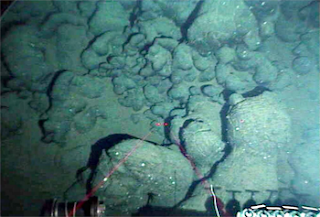Basalt, the rock formed from flowing lava, is porous, and it neutralizes acids. It is an excellent place to store carbon dioxide, so says Columbia University professor David Goldberg in PNAAS (Jan 4 2010). The reason this is encouraging is that there is a lot of basalt in the world, and the carbon dioxide reacts to form limestone rock -- that will stay there forever.
Of course, carbon dioxide emissions are causing climate change, and pilot plants are being built to contain it. See this previous post from hometown Kenosha.
The volcanic basalt formed as the continents drifted apart over the millennia. Volcano's filled in the gap between the continents with lava from the earth's interior.
Basalt deposits are phenomenally big, that is why this represents the first practical carbon sequestration solution. It is estimated that one formation in the Pacific could hold the entire US carbon dioxide output for 120 years, or 210 gigatons or 2.1E14 kg. Don't forget that after a few hundred years, the fossil fuels will run out, so the carbon dioxide problem will eventually go away by itself.
Chemically this is what happens. Carbon dioxide is an acidic when it is in water. People call that carbonic acid. It can be neutralized by calcium, iron or magnesium that is present in basalt rock.
H_2O + CO_2 = H_2CO_3
2H_2CO_3 + Ca++ = CaCO_3 (Limestone) + 2H+
This is already being demonstrated in the Carbfix project in Iceland. To make this practical pipelines would need to be built from the power plants to the geological sites, but basalt is all over, and it should not be more difficult that extracting petroleum.
Absorption of carbon dioxide on peridotite, another mineral, is also interesting. A new posting is pending.
.
Joker
-
*Plot:* Arthur Fleck (Joaquin Phoenix) is a down-and-out clown living with
his mom in 1960's era Gotham City. He works a comedy clubs, events at
stores, a...
5 years ago










No comments:
Post a Comment
What do you have to say?